Gathering land, food & tradition at the Eden Project
An exhibition at the Eden Project in Cornwall featuring international
artists explores our relationship to the land and food. Will Jennings looks at
rituals and practices across different nations, to find lines can be drawn
across time and place which may offer ideas to heal our relationship in the future.
For over two decades the Eden Project has offered Cornish
tourists an escape from the very county they are they to visit and explore.
Within the confines of a former claypit, the natural environments of Africa, Central
and Southern America, tropical islands, California, Australia and the
Mediterranean have been compressed together into an other-worldly experience beneath
Nicholas Grimshaw’s celebrated biodomes. Beyond the pleasure-seeking thrill of
Amazonian tree-top walks, a zipwire ride, and navigating the world in an
afternoon, it is also an important research centre into natural restoration and
ecological sustainability.
This happens through growing and science, but also through art and culture. An art gallery sits within the Core Building, a timber-structure designed by Jolyon Brewis of Grimshaw and Partners who drew from mathematical opposing spirals of pinecones and sunflowers. Originally constructed as the Eden Project’s offices, in 2018 it was converted into a community space, laboratory, and an arts centre which hosts exhibitions curated in tandem with the organisation’s scientific research and critical thinking.
The current exhibition, Acts of Gathering, presents a series of projects which consider our relationship to land and food within a changing environment. It is designed less as a fine-art top-down presentation of worldly knowledge, and more as a space of discovery and engagement towards how different cultures engage with and ritualise the land, and suitably begins with the offer for visitors to create their own totem to nature.
![]()
![]()
Brazilian artist Maria Nepomuceno’s video offers instructions to make an animal or natural element from clay, inviting the visitor to write a small note of how to improve the planet onto a piece of paper then secreting it within the creation. After being fired, these will then find their way onto an intricately woven straw and fabric sculpture which splays open to provide a surface to hold the growing collection of creatures and plants. Within each is a unique message, together they suggest a collective language of solidarity which will be needed to support change, the terracotta sculptures sit waiting like ritualistic totems.
![]()
![]()
![]()
![]()
Cornish artists Nina Royle and Lucy Stein also bring forth a sense of ritual and collective honour. A table sits at the centre of a mixed-media set piece which suggests of a harvest festival offering. Straw is bound and arranged, but amongst the array of drawings and objects things veer away from a Christian festival and deeper into its pagan roots. “A neck! A neck!” is written on the wall, referencing the Cornish Crying the Neck ceremony when the final shock of corn is cut from the land and held aloft to a collective proclamation.
The work speaks to more. Into the relationship of ritual to land are folded notions of femininity as well as questions around the history and rise of neo-paganism, and the post-harvest fallow period of land. “In capitalist production, that seasonal pause gets lost,” says Royle, speaking to an ever industrialised control of land which not only flattens out history, custom, and quirks of culture, but also the passage and rhythm of time.
![]()
![]()
![]()
![]()
![]()
![]()
![]()
![]()
Jonathan Baldock also uses corn in his contribution to Acts of Gathering. He has shaped it into four sinister masks, human-scale faces for imagined life-size corn dollies. There is both theatricality and fear within the anonymity and stuck expressions, perhaps aware of the eventual fate of the corn dolly as part of a sacrificial offer to the earth ahead of re-sowing.
There are more rituals in the work of Serge Attukwei Clottey, both new and old. A song calls the visitor towards bright yellow tent-like drapery, and once under its protective roof it can be heard more clearly. Better Days are Coming (2016-21) is an audio recording of the Ghanaian Ga people singing at their Homowo harvest festival, an event to remember what both the land has given, but also to keep in mind the famines of the pre-colonial country. With climate change pressing, poor crops recur and famines again threaten.
The hanging ceiling and walls suddenly feel less secure, just as the enticing song is discovered to be a refrain of loss and fear. It turns out that it’s made of cut up fragments of plastic oil drums, symbols of the Global North and toxicity, their history of national and corporate control and extraction here transformed into a semi-protective shelter. But, just as the beautiful song reminds of loss, Clottey’s re-manufactured material offers shade but in doing so constantly tells the story of the yellow plastic’s history. The repurposing of the barrels into such hanging structures is what the artist terms Afrogallonism, and the transformative process of cleaning, breaking apart, then stitching together the oil drums is itself a modern ritualistic process, one of undoing and reimagining.
![]()
![]()
![]()
The battle between modern corporate practice and an indigenous custodianship is present elsewhere. A triptych video work by Swiss artist Uriel Orlow takes the Artemisia afra plant as its focus, exploring the sustainable cultivation of it by a woman’s cooperative in Lumata in the Democratic Republic of Congo. It is a plant which offers a traditional medicine to care for the local population, an infusion of its leaves reportedly prevents and treats malaria, and the cooperative that Orlow both made the film of and spent several months working in uses proceeds from its sale to fund a collective health insurance.
One screen is devoted to a beautiful Congo folk song which speaks to the medicinal qualities of the plant, the lyrics extolling the values of choosing Artemisia afra over big pharma’s expensive pills. Another screen records the harvest process, accompanied by song, while the centre offers a bullet point essay over the geopolitics and post-colonial control of medicine.
![]()
![]()
![]()
It’s a small exhibition, but deep in idea and provocation, and within the few works on show strands can be drawn across cultures, time, and practice. The exhibition also spills outside of the gallery space – Jumana Manna’s film Foragers (2022) is being shown at CAST in Helston, deeper into the county, while Serge Attukwei Clottey will be coming over to the Eden Project to take part in their annual Reclaim Festival of mental and planetary wellbeing, 27-28 January 2024.
It's not the only contemporary art on display at the Eden Project. There are fifteen site-responsive installations across the landscaped site and within the two biodomes from artists including Ai Weiwei, Ryan Gander, Alexandra Daisy Ginsberg, and El Anatsui. They, and the gallery, may not be the prime driver for visitors to the centre, but the works are more than a distraction or decoration to the plantlife on show, and instead seek to conjoin creative and scientific research into a progressive way of thinking about the world which draws on millennia of shared histories across human and non-human existence.
This happens through growing and science, but also through art and culture. An art gallery sits within the Core Building, a timber-structure designed by Jolyon Brewis of Grimshaw and Partners who drew from mathematical opposing spirals of pinecones and sunflowers. Originally constructed as the Eden Project’s offices, in 2018 it was converted into a community space, laboratory, and an arts centre which hosts exhibitions curated in tandem with the organisation’s scientific research and critical thinking.
The current exhibition, Acts of Gathering, presents a series of projects which consider our relationship to land and food within a changing environment. It is designed less as a fine-art top-down presentation of worldly knowledge, and more as a space of discovery and engagement towards how different cultures engage with and ritualise the land, and suitably begins with the offer for visitors to create their own totem to nature.
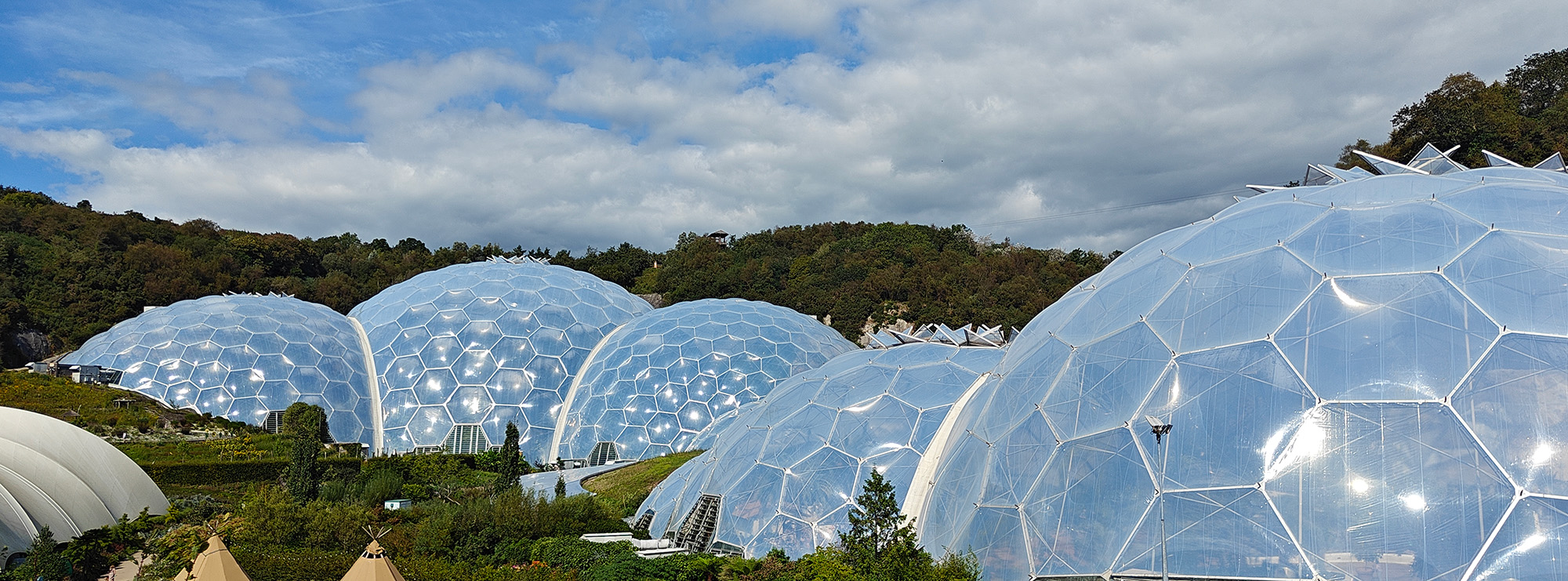

Figs.i,ii
Brazilian artist Maria Nepomuceno’s video offers instructions to make an animal or natural element from clay, inviting the visitor to write a small note of how to improve the planet onto a piece of paper then secreting it within the creation. After being fired, these will then find their way onto an intricately woven straw and fabric sculpture which splays open to provide a surface to hold the growing collection of creatures and plants. Within each is a unique message, together they suggest a collective language of solidarity which will be needed to support change, the terracotta sculptures sit waiting like ritualistic totems.




Figs.iii-vi
Cornish artists Nina Royle and Lucy Stein also bring forth a sense of ritual and collective honour. A table sits at the centre of a mixed-media set piece which suggests of a harvest festival offering. Straw is bound and arranged, but amongst the array of drawings and objects things veer away from a Christian festival and deeper into its pagan roots. “A neck! A neck!” is written on the wall, referencing the Cornish Crying the Neck ceremony when the final shock of corn is cut from the land and held aloft to a collective proclamation.
The work speaks to more. Into the relationship of ritual to land are folded notions of femininity as well as questions around the history and rise of neo-paganism, and the post-harvest fallow period of land. “In capitalist production, that seasonal pause gets lost,” says Royle, speaking to an ever industrialised control of land which not only flattens out history, custom, and quirks of culture, but also the passage and rhythm of time.
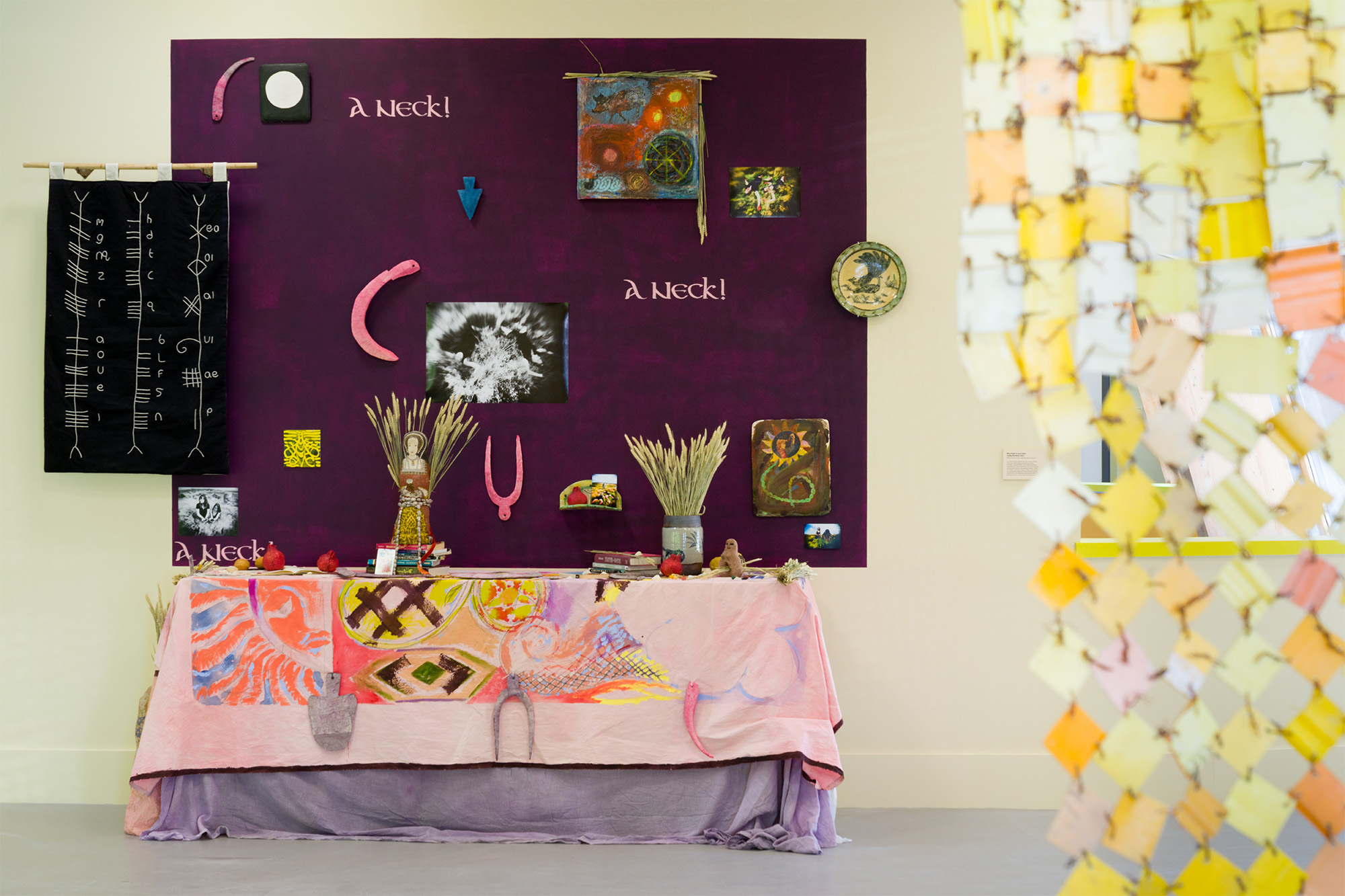

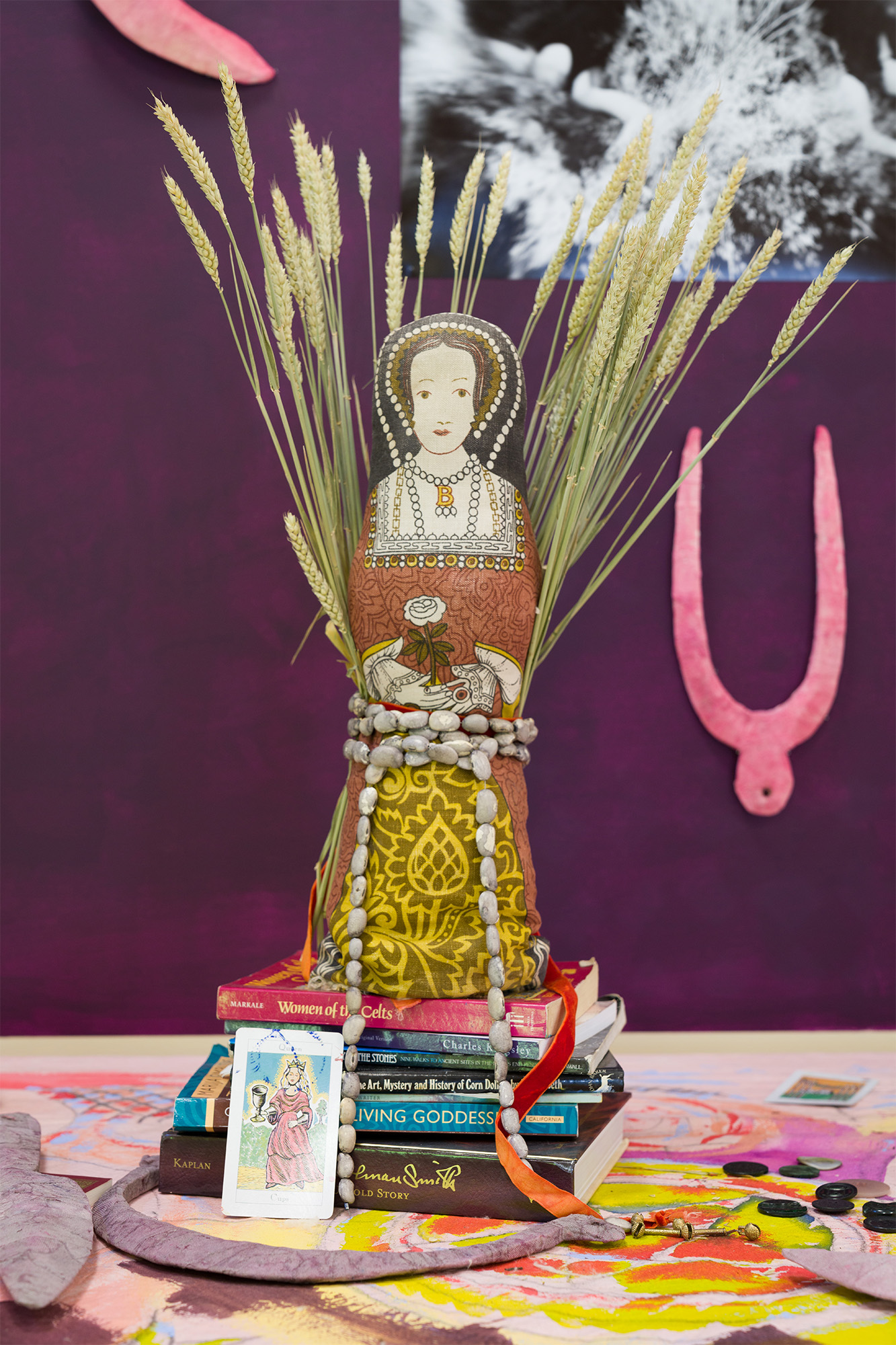
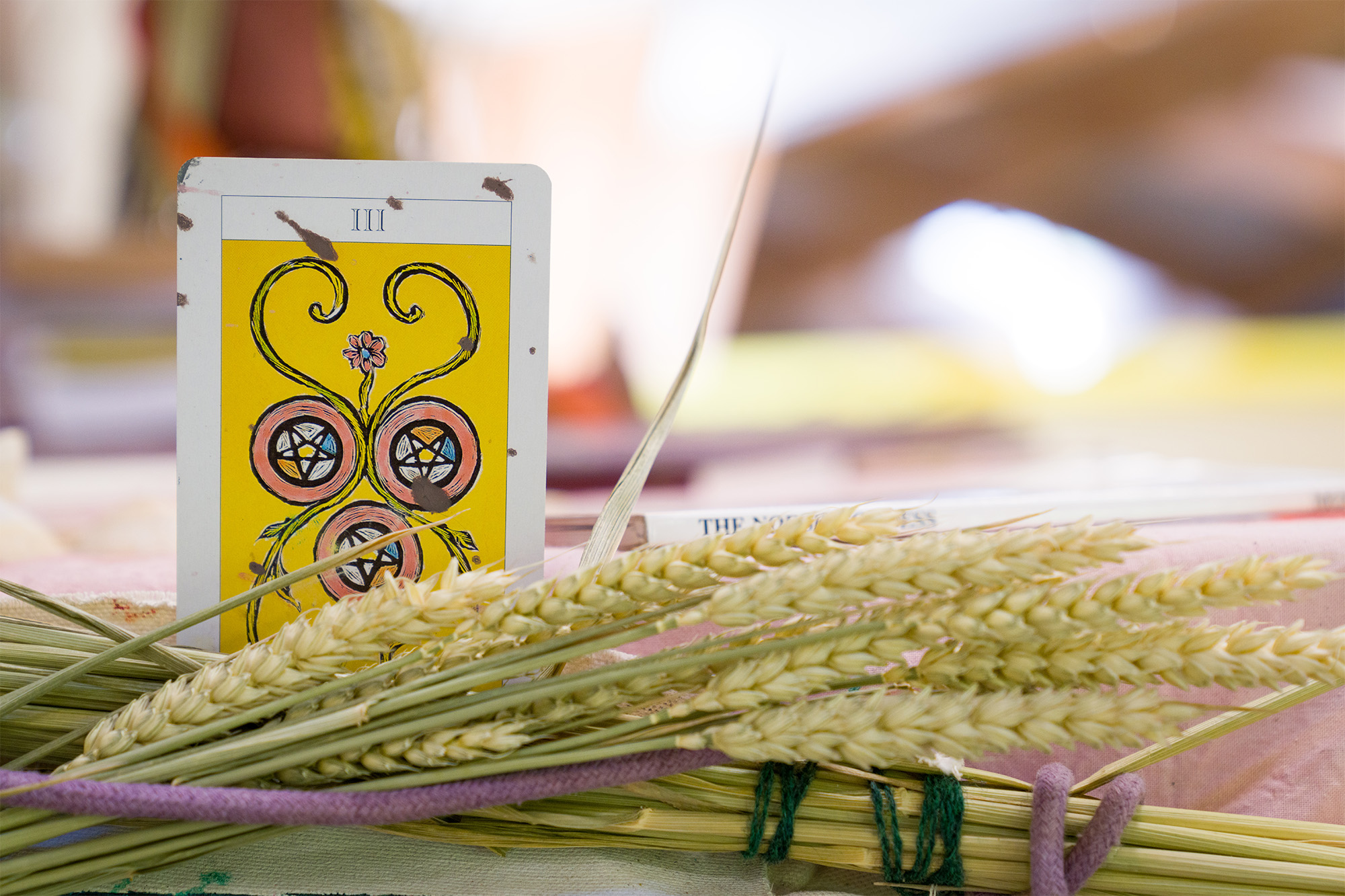
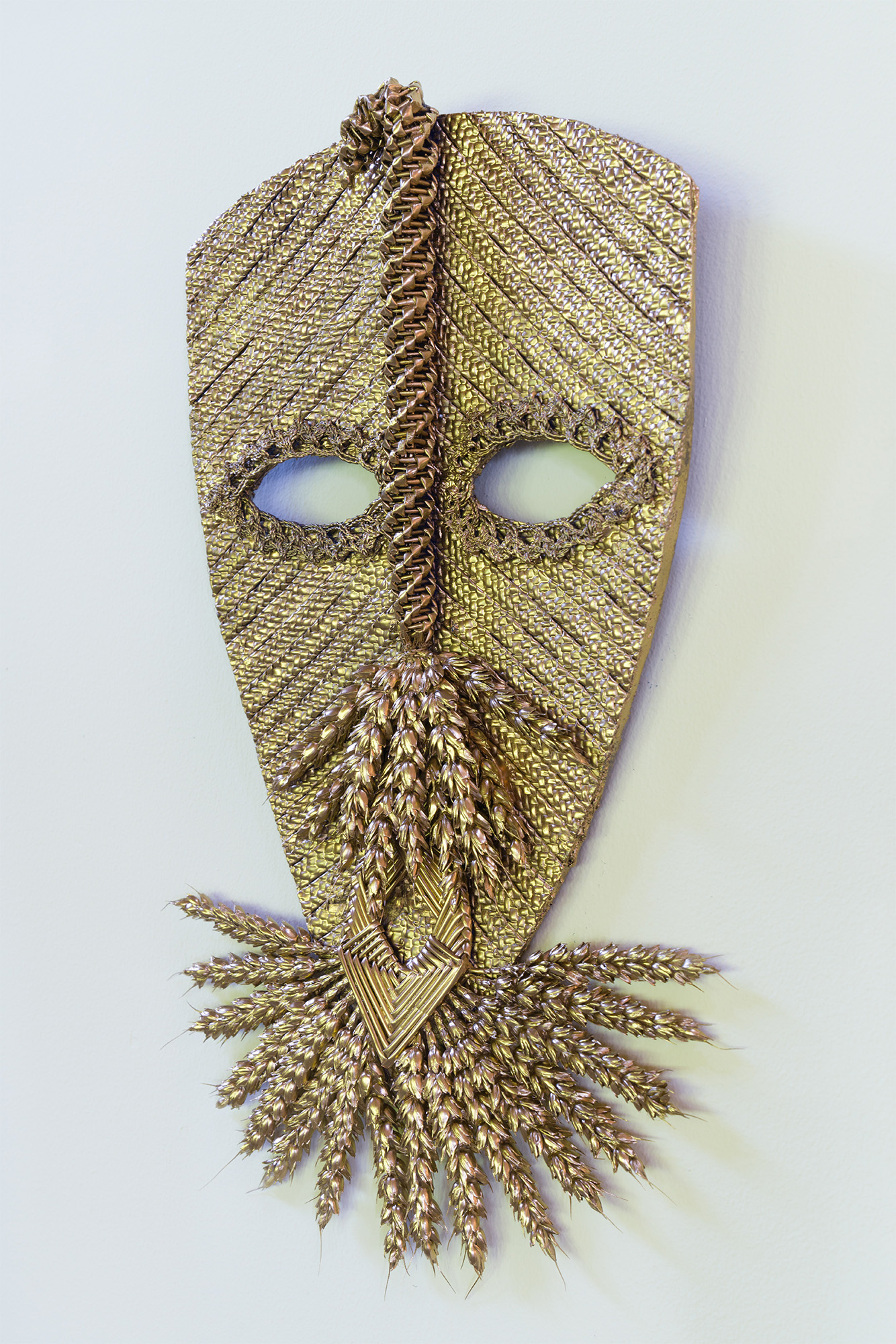
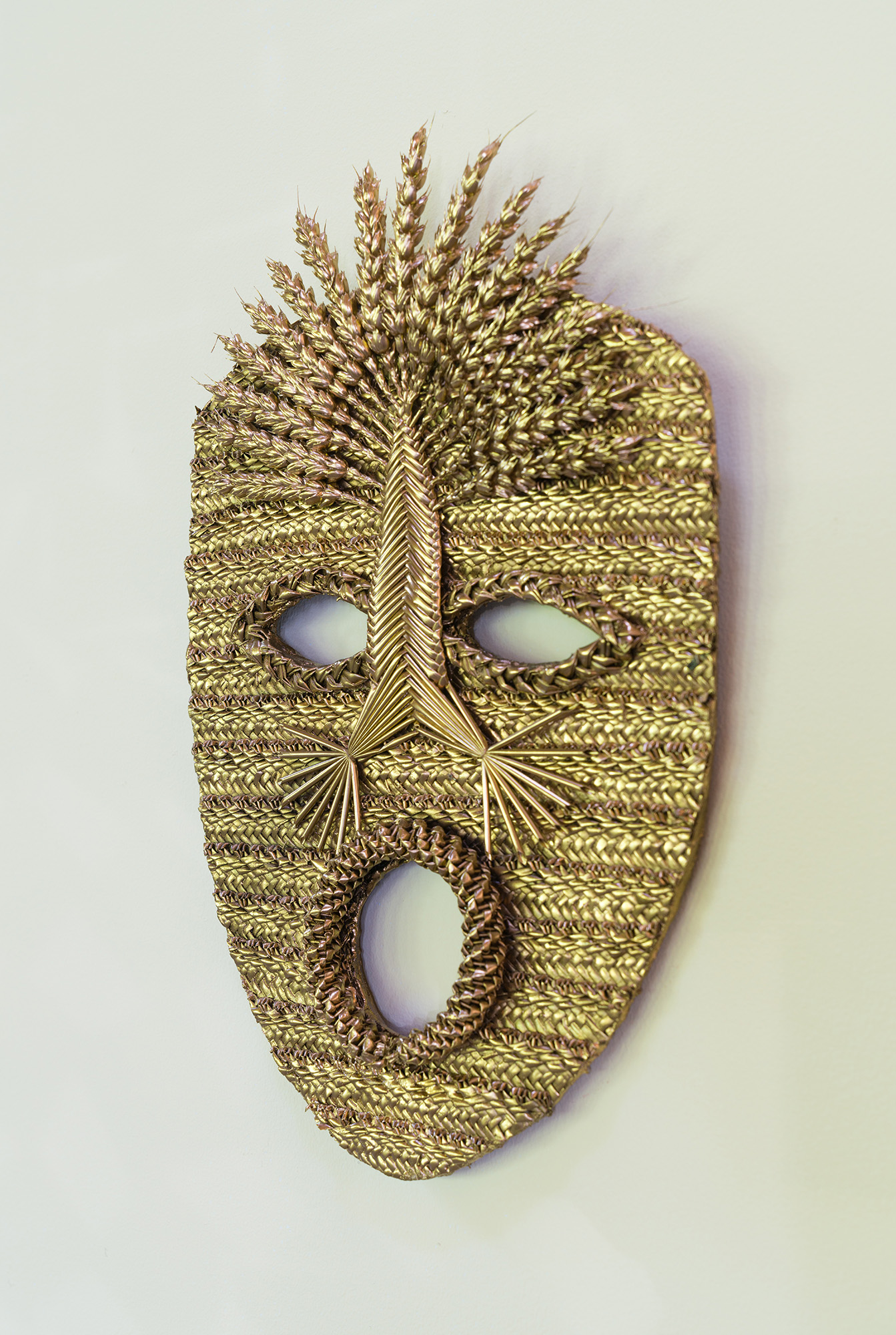

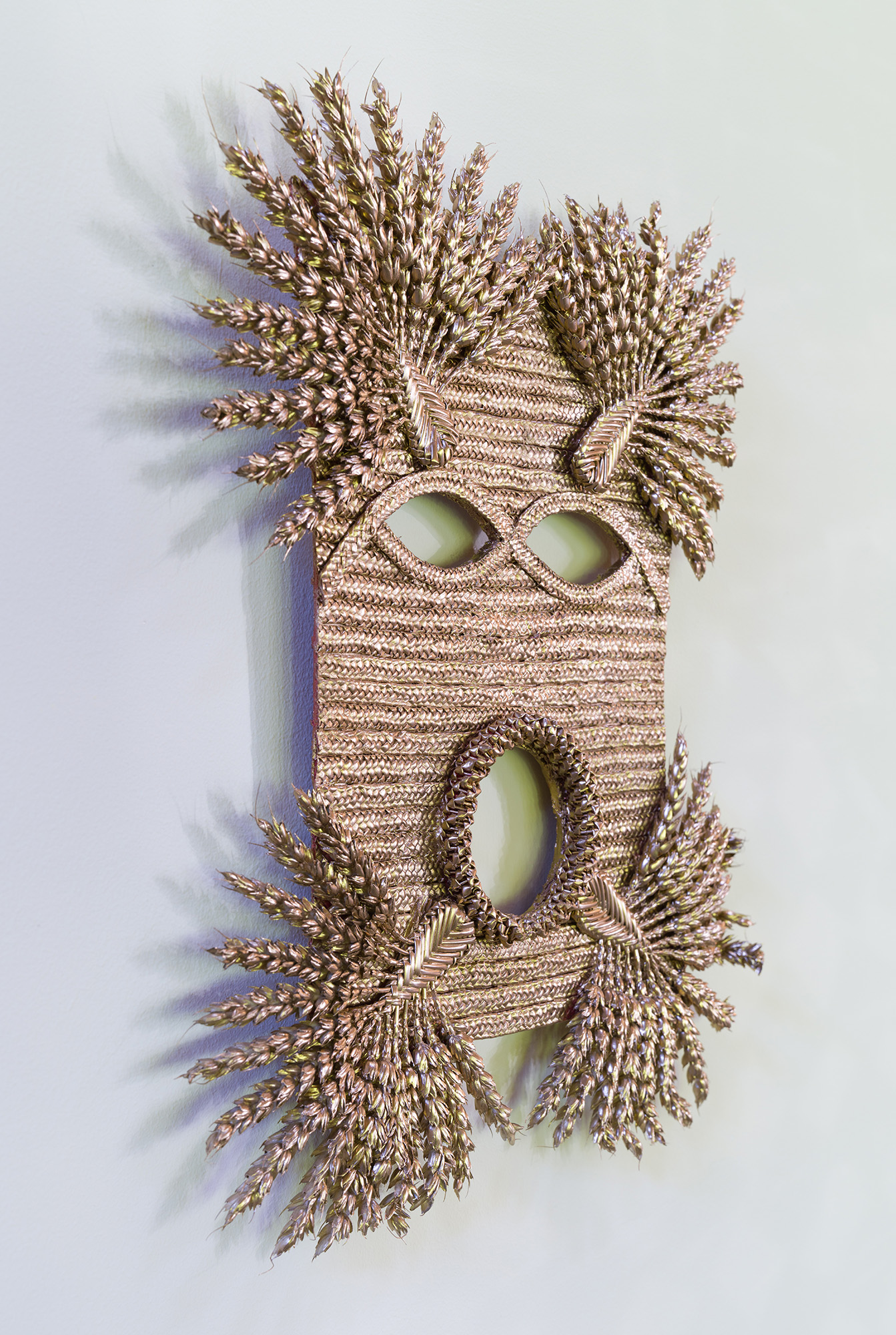
Figs.vii-xiv
Jonathan Baldock also uses corn in his contribution to Acts of Gathering. He has shaped it into four sinister masks, human-scale faces for imagined life-size corn dollies. There is both theatricality and fear within the anonymity and stuck expressions, perhaps aware of the eventual fate of the corn dolly as part of a sacrificial offer to the earth ahead of re-sowing.
There are more rituals in the work of Serge Attukwei Clottey, both new and old. A song calls the visitor towards bright yellow tent-like drapery, and once under its protective roof it can be heard more clearly. Better Days are Coming (2016-21) is an audio recording of the Ghanaian Ga people singing at their Homowo harvest festival, an event to remember what both the land has given, but also to keep in mind the famines of the pre-colonial country. With climate change pressing, poor crops recur and famines again threaten.
The hanging ceiling and walls suddenly feel less secure, just as the enticing song is discovered to be a refrain of loss and fear. It turns out that it’s made of cut up fragments of plastic oil drums, symbols of the Global North and toxicity, their history of national and corporate control and extraction here transformed into a semi-protective shelter. But, just as the beautiful song reminds of loss, Clottey’s re-manufactured material offers shade but in doing so constantly tells the story of the yellow plastic’s history. The repurposing of the barrels into such hanging structures is what the artist terms Afrogallonism, and the transformative process of cleaning, breaking apart, then stitching together the oil drums is itself a modern ritualistic process, one of undoing and reimagining.
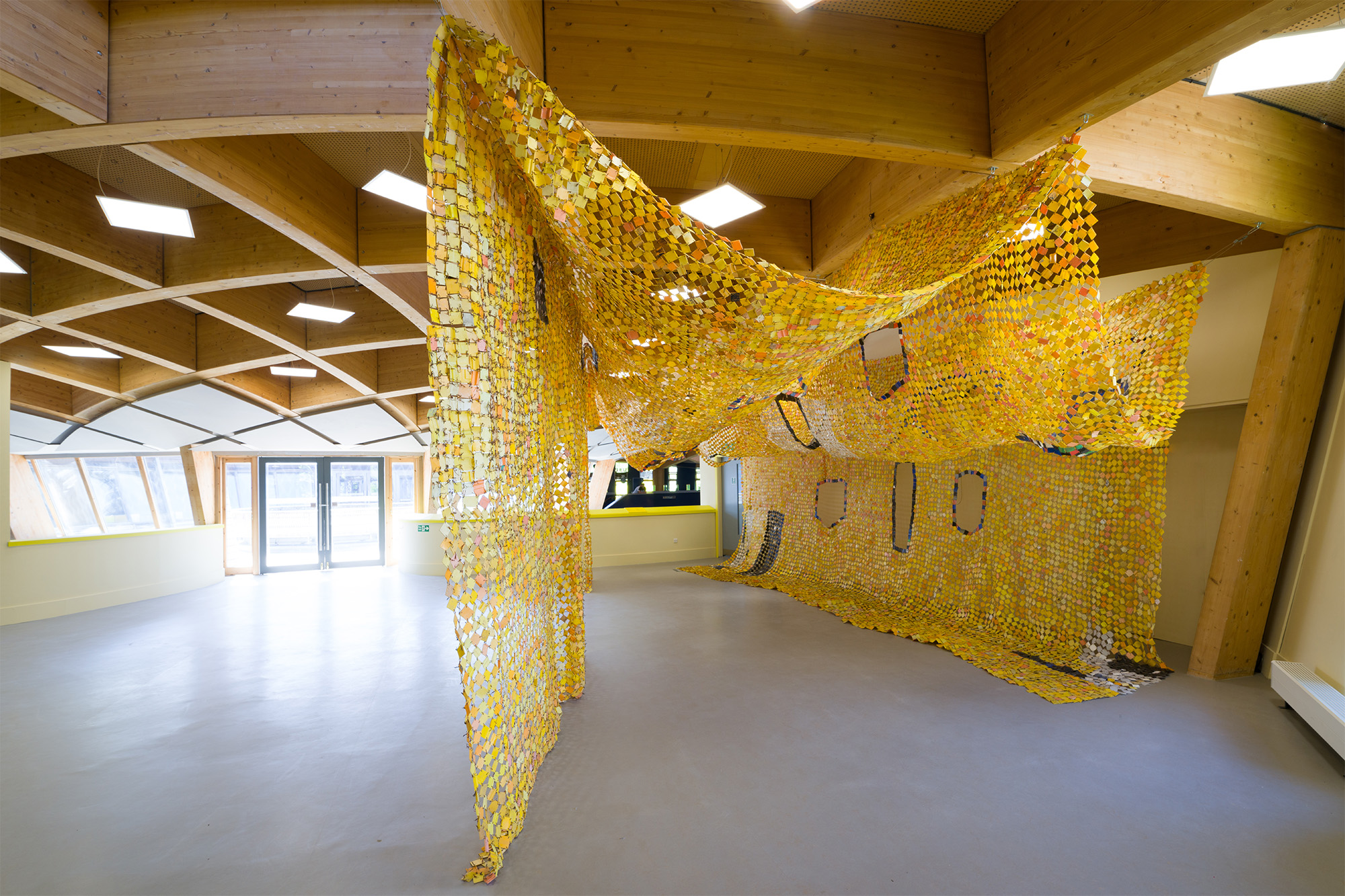
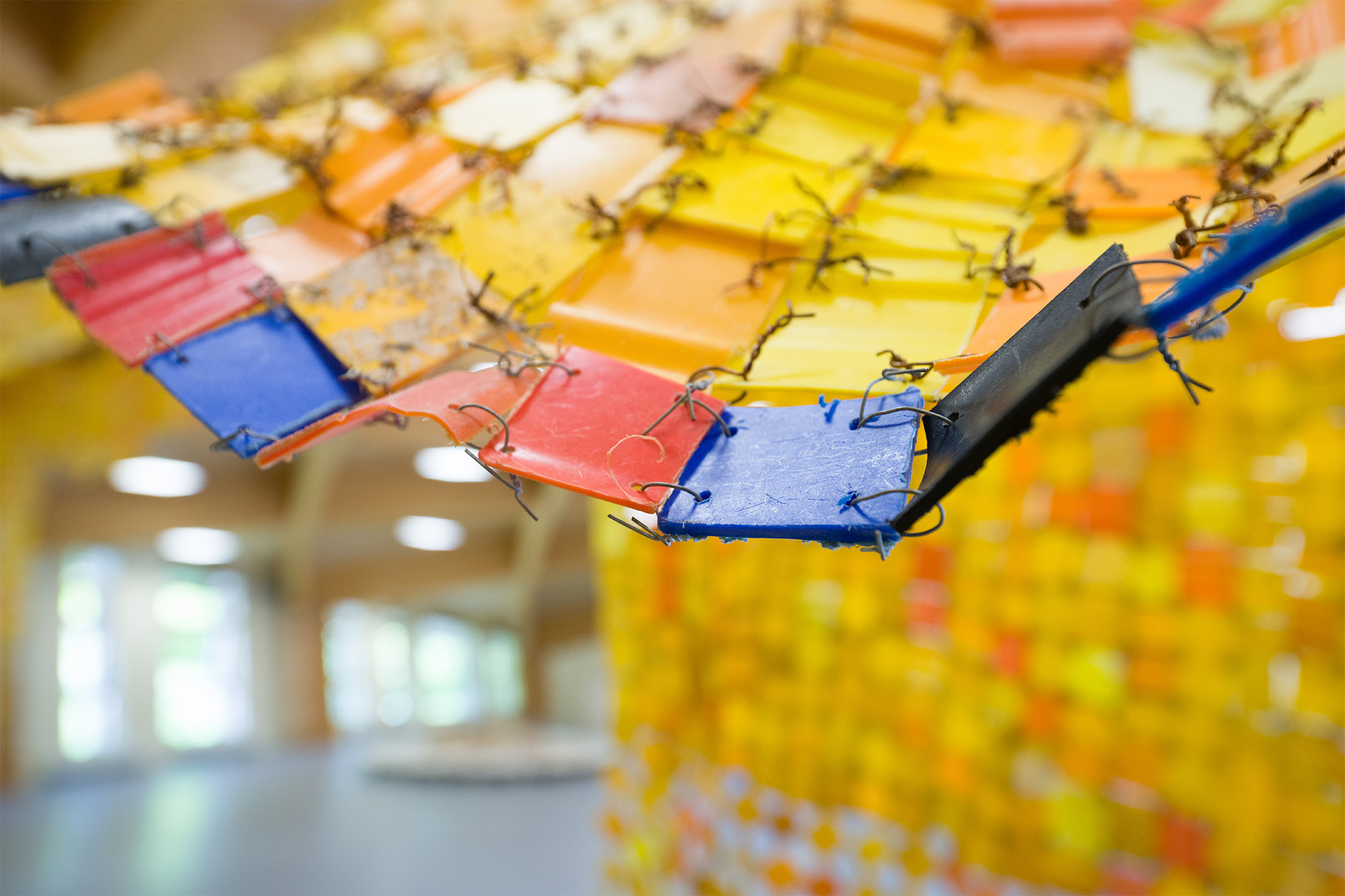

Figs.xv-xvii
The battle between modern corporate practice and an indigenous custodianship is present elsewhere. A triptych video work by Swiss artist Uriel Orlow takes the Artemisia afra plant as its focus, exploring the sustainable cultivation of it by a woman’s cooperative in Lumata in the Democratic Republic of Congo. It is a plant which offers a traditional medicine to care for the local population, an infusion of its leaves reportedly prevents and treats malaria, and the cooperative that Orlow both made the film of and spent several months working in uses proceeds from its sale to fund a collective health insurance.
One screen is devoted to a beautiful Congo folk song which speaks to the medicinal qualities of the plant, the lyrics extolling the values of choosing Artemisia afra over big pharma’s expensive pills. Another screen records the harvest process, accompanied by song, while the centre offers a bullet point essay over the geopolitics and post-colonial control of medicine.
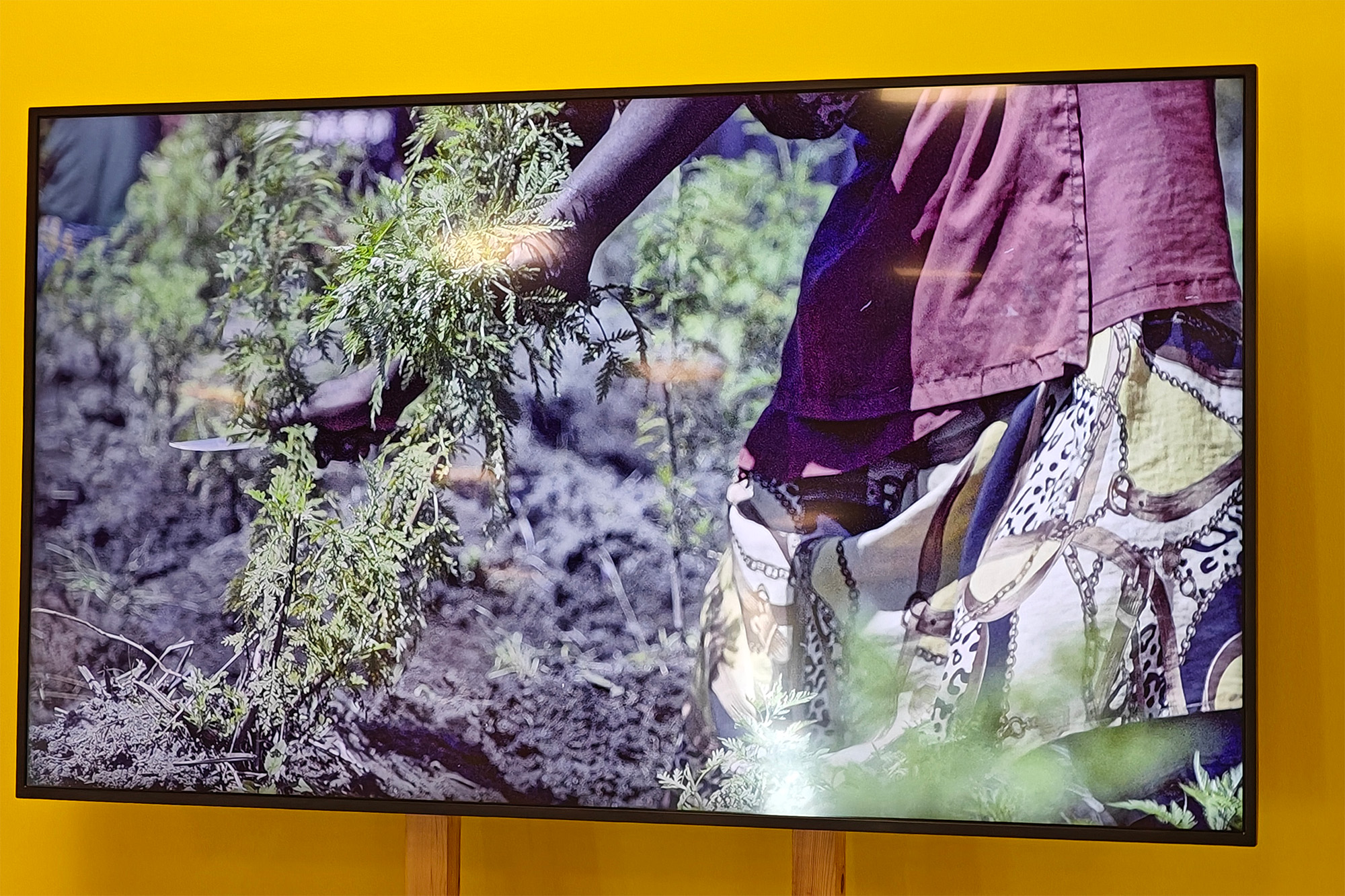
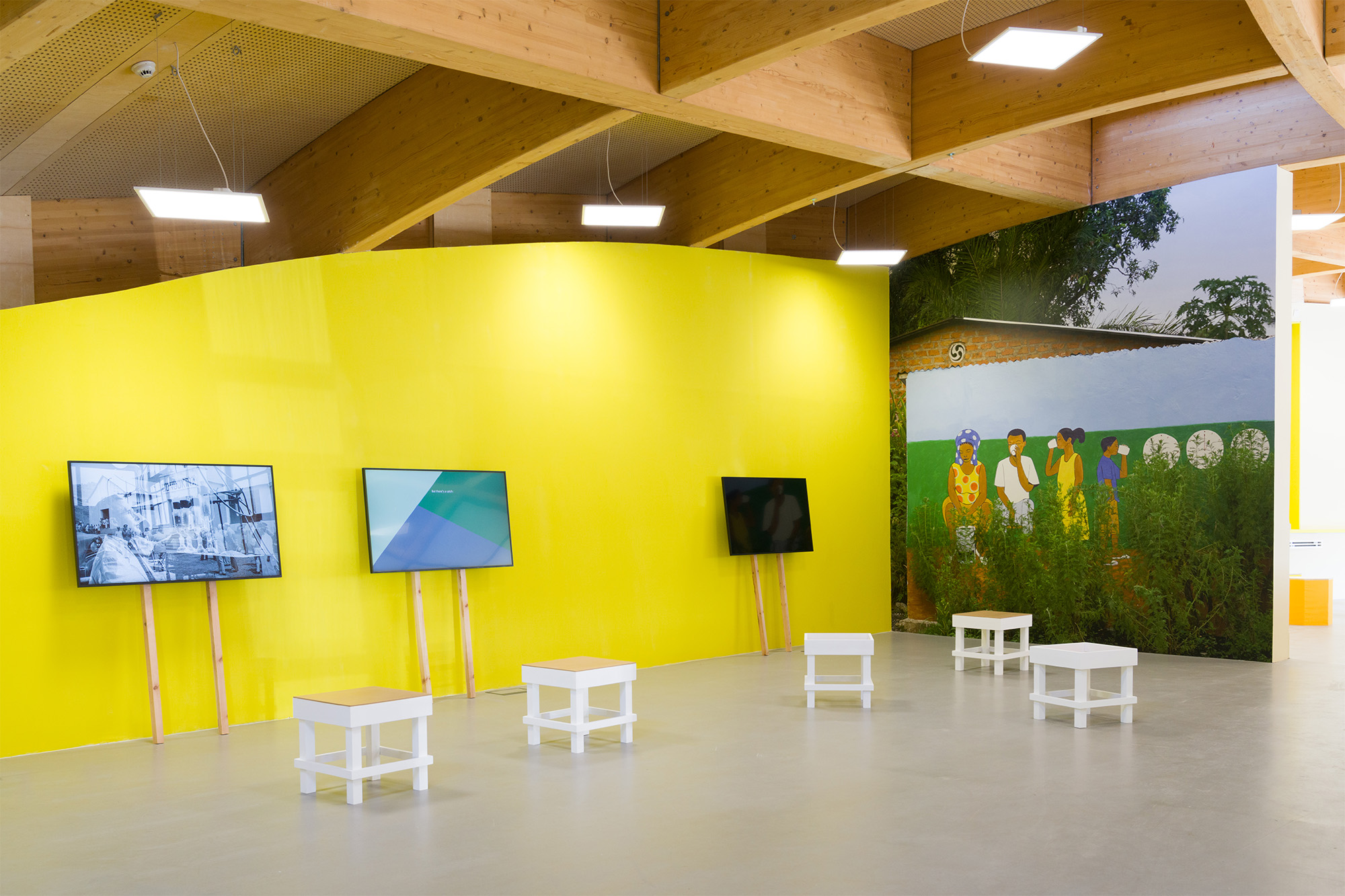

Figs.xviii-xx
It’s a small exhibition, but deep in idea and provocation, and within the few works on show strands can be drawn across cultures, time, and practice. The exhibition also spills outside of the gallery space – Jumana Manna’s film Foragers (2022) is being shown at CAST in Helston, deeper into the county, while Serge Attukwei Clottey will be coming over to the Eden Project to take part in their annual Reclaim Festival of mental and planetary wellbeing, 27-28 January 2024.
It's not the only contemporary art on display at the Eden Project. There are fifteen site-responsive installations across the landscaped site and within the two biodomes from artists including Ai Weiwei, Ryan Gander, Alexandra Daisy Ginsberg, and El Anatsui. They, and the gallery, may not be the prime driver for visitors to the centre, but the works are more than a distraction or decoration to the plantlife on show, and instead seek to conjoin creative and scientific research into a progressive way of thinking about the world which draws on millennia of shared histories across human and non-human existence.
The Eden Project, co-owned by the Eden Trust, is a global arts, science and educational charity with a social and environmental mission: to create a movement that builds relationships between people and the natural world to demonstrate the power of working together for the benefit of all living things. Eden champions creativity and critical thinking, and presents thoughtful and thought-provoking cross-disciplinary cultural, community and education programmes on-site and across local and national communities.
Founded as a Millennium Project in 2001, Eden has a digital reach of several million and as Eden Project establishes new sites across the UK and in China, Australia and New Zealand, its reach is growing. Eden is at the forefront of emerging cultural practices in regeneration, conservation, sustainability, horticulture, architecture, community outreach and education. The organisation has an extensive network of scientific expertise and partners at leading local, national and international universities and research bodies.
The world-famous Biomes house a living ethno-botanical collection. To date Eden has commissioned and exhibited such world-revered and diverse artists as El Anatsui, Wolfgang Buttress, Hayden Dunham, Ryan Gander, Jenny Kendler, Julian Opie, Peter Randall-Page, Tim Shaw and Studio Swine. Eden is a hybrid of gallery, museum, garden, venue, laboratory and university – a cross-disciplinary cultural leader for the 21st century, uniquely placed to offer transformative opportunities to artists engaged with social-environmental subjects.
Eden believes that art has the power to challenge perceived wisdom, to provoke, captivate and inspire. That the planetary emergency is rooted in human culture. That social equity and environmental harmony are deeply connected to, and can be transformed by, cultural exchange. In order to develop a vision for a planet fit for the future we need to nurture creative perspectives.
www.edenproject.com
Will Jennings is a London based writer, visual artist, and educator interested in cities, architecture, and culture. He has written for the RIBA Journal, the Journal of Civic Architecture, Quietus, The Wire, the Guardian, and Icon. He teaches history and theory at UCL Bartlett and Greenwich University, and is director of UK cultural charity Hypha Studios.
www.willjennings.info
www.willjennings.info
visit
Acts of Gathering is presented at The Eden Project, Cornwall
until April 2024. The exhibition is included within Eden admission,
pre-booking is strongly encouraged. More details at:
https://www.edenproject.com/visit/whats-on/acts-of-gathering
Jumana Manna’s film Foragers (2022) is being shown at
CAST in Helston, 2-28 September, 2023. Details at:
https://c-a-s-t.org.uk/event/foragers-jumana-manna/
images
figs.i,ii The Eden Project Biodomes and Core Building. Photographs © Will Jennings.
figs.iii,iv,vi
Maria Nepomuceno, Você me alimenta (You feed me), 2022. Straw, fabric and ceramic. Photos © Will Jennings.
fig.v Maria Nepomuceno,
Você me alimenta (You feed me), 2022. Straw, fabric and ceramic. Photo
© Steve Tanner.
fig.vii-x Nina Royle & Lucy Stein, Crying the Neck, 2023. Mixed media (ceramic, painting, found objects). Ceramic vase, shelf and plate: Debbie Prosser.
Photo ©
Steve Tanner.
figs.xi-xiv
Jonathan Baldock,
Corn Dolly V, II, I & III, 2012. Corn/wheat, card and paint.
Photos ©
Steve Tanner.
figs.xv-xvii Serge Attukwei Clottey, Noko Y3 Dzen (Something in the world), 2018-2019.
Plastic and copper wire.
Installation view.
Photos ©
Steve Tanner.
figs.xviii,xx
Uriel Orlow, Learning from Artemisia, 2019-2020
Mixed media (wallpaper, 3-channel video, tables and chairs). Photos © Will Jennings.
fig.xix Uriel Orlow, Learning from Artemisia, 2019-2020
Mixed media (wallpaper, 3-channel video, tables and chairs). Installation View. Photo ©
Steve Tanner.
publication date
20 September 2023
tags
Artemisia afra, Serge Attukwei Clottey, Acts of Gathering, Jonathan Baldock, Biodome, Jolyon Brewis, Corn, Cornwall, Democratic Republic of Congo, Eden Project, Ghana, Nicholas Grimshaw, Grimshaw and Partners, Harvest, Homowo, Land, Will Jennings, Jumana Manna, Medicine, Nature, Maria Nepomuceno, Uriel Orlow, Ritual, Nina Royle, Lucy Stein
https://www.edenproject.com/visit/whats-on/acts-of-gathering
Jumana Manna’s film Foragers (2022) is being shown at CAST in Helston, 2-28 September, 2023. Details at:
https://c-a-s-t.org.uk/event/foragers-jumana-manna/


